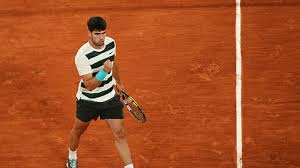Coco Gauff’s Tactical Triumph: How the American Star Conquered Sabalenka in a Roland Garros Classic

In a gripping showdown on Court Philippe Chatrier, Coco Gauff showcased resilience, strategic maturity, and unwavering composure to defeat world No. 1 Aryna Sabalenka 6-7(5), 6-2, 6-4 and clinch her second Grand Slam title. The win not only marked redemption for her 2022 final loss at Roland Garros but also reaffirmed her growing dominance on the biggest stages, particularly against Sabalenka.
1. Weathering the Storm: Surviving a Grueling First Set
Sabalenka came out firing, racing to a 4-1 lead with a double-break advantage. Gauff appeared overwhelmed initially, struggling with depth and Sabalenka’s aggressive shot-making. But the tide turned when Sabalenka, serving at 40-0 in the sixth game, crumbled under pressure with two double faults and a loose backhand — a momentum-shifting collapse that allowed Gauff to rattle off 12 consecutive points and level the set.
Despite the resurgence, Gauff handed back the break immediately and Sabalenka had multiple opportunities to close the set. However, nerves and erratic serving plagued the Belarusian, as she failed to convert two set points, including one with yet another double fault.
The set eventually culminated in a tie-break — the first in a French Open women’s final since 1998 — which Sabalenka edged with a four-point streak, but not before both players endured a 77-minute marathon that tested their endurance and mental resolve.
2. Reset and Rebuild: Gauff’s Dominant Second Set
Where Sabalenka faltered in turning momentum into control, Gauff excelled. She returned to the court in the second set with a noticeably clearer plan: extend rallies, exploit Sabalenka’s backhand under pressure, and patiently wait for errors.
Breaking twice early, Gauff jumped to a 4-1 lead. Crucially, she showed the composure Sabalenka lacked in the opening set, serving out the set with conviction and converting her first set point with a crisp overhead at the net. She capitalized on Sabalenka’s 70 unforced errors throughout the match, many of which came in blustery conditions that made timing difficult — especially for the more power-oriented Sabalenka.
3. The Decider: Turning Pressure into Performance
Gauff’s ability to stay consistent while Sabalenka’s game fluctuated wildly was the story of the third set. After breaking early to go up 2-1, Gauff saw Sabalenka claw back to 3-3. But the American held her nerve, breaking Sabalenka to love in the very next game.
Serving for the match at 5-4, Gauff faced one last test: a match point saved by a fearless Sabalenka return and a break point against her. But Gauff’s movement and court coverage bailed her out, and on her second match point, she forced an error from Sabalenka before collapsing to the clay in triumph.
4. Match Stats Tell the Story
- Unforced Errors: Sabalenka – 70 | Gauff – 29
- Double Faults: Sabalenka – 10
- Break Points Converted: Gauff – 7/14 | Sabalenka – 5/13
- Total Time: 2 hours, 38 minutes
These numbers underline a key takeaway — Gauff didn’t need to overpower Sabalenka. She just needed to outlast her. Her strategy of absorbing pace, forcing longer exchanges, and making fewer mistakes paid dividends.
5. Head-to-Head Edge and Mental Fortitude
With this win, Gauff now leads their head-to-head 6-5, and has beaten Sabalenka in back-to-back Slam finals. More importantly, she has proven she can adjust mid-match, a quality that separates the good from the great. At just 21, she has already captured two major titles — both after dropping the first set.
This Roland Garros title not only solidifies her place among the elite but signals a potential shift in the WTA hierarchy. While Sabalenka continues to chase history, Gauff’s calm under fire might be what ultimately defines the next era of women’s tennis.





